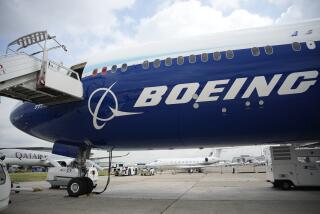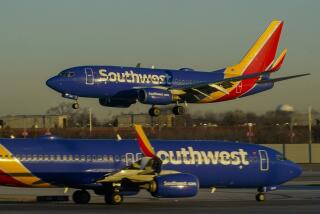A Sky Full of Imitators : UPSTART CHALLENGER : Reno: Biggest Little Risk in the Industry?
- Share via
The name is Reno Air, but it could just as easily be called American Airlines Jr.
Each day, Reno grows closer to the troubled Texas-based behemoth, which is retreating from money-losing short flights to concentrate on more profitable cross-country routes.
American has been handing off many of its West Coast runs to 17-plane Reno rather than try to compete with discount carrier Southwest Airlines. Though American loses ticket revenue in the process, it hopes to at least maintain passenger loyalty.
To ensure that former customers understand the connection, Reno--one of a new breed of low-cost carriers--shares ground crews and ticket counter space with American in many of the 11 cities it serves. It also offers miles in American’s frequent-flier and summer travel programs.
But the relationship is not as beneficial to Reno as one might think.
Aloft barely two years, Reno has suffered two consecutive quarters of losses as it has realigned itself to take advantage of its “strategic relationship” with American and cut non-productive routes.
The changeover has also brought Reno into direct competition with industry leader Southwest on flights to San Jose from a number of airports, including Los Angeles International, San Diego’s Lindbergh Field and John Wayne Airport in Orange County, where it began service Thursday.
The result: One airline forecaster now considers Reno at high risk for financial trouble.
“They have gradually moved out of their niche,” said Steve Lowry, president of Aviation Forecasting & Economics in Arlington, Va. “They really stepped onto some competitive routes that the incumbents are not going to let them penetrate.”
Reno is more inclined to view its setbacks as growing pains, the consequence of taking advantage of its new relationship with American. Those ties are prompting a metamorphosis for an airline that started out trying to match the service of the long-haul carriers while offering the fares of short-haul fliers, notably Southwest.
“The monsters’ costs were too high, and the new entrants were offering a cheapie product,” said Reno’s colorful chairman, Lee Hydeman. “My view was you could offer a good product at a good price.”
So Reno keeps costs relatively low on the scale used by the airline industry--8 cents to fly one passenger one mile, compared to Southwest’s 7.14 cents--while offering assigned seating, snacks, meals and first-class sections. Southwest eschews such perks.
Reno charges the same fare or only a couple of dollars more than Southwest on most routes. The one-way, anytime fare from Los Angeles to San Jose, for instance, is $69 on Southwest and $72 on Reno.
To hold down costs, Reno has taken advantage of the fire-sale bargains created in the recession-ravaged airline industry.
It bought leftover equipment from defunct airlines such as Chicago-based Midway for as little as 10 cents on the dollar. An aircraft glut allowed it to lease several new MD-80 jetliners at cut rates. Its work force came largely from those displaced by the collapse of Midway and other carriers, many of whom are earning less than at their former jobs.
Reno is also borrowing a few ideas from Southwest. It flies only MD-80s, which lowers maintenance and repair costs, and it keeps ground time to a minimum.
Is Southwest worried? “I’m sure we can compete against any carrier,” spokesman Ed Stewart said. “Our market share in California has been growing and still is growing. We think that’s a testament to what the customer is after.”
Reno began to turn a profit within months after it started flying in 1992. “The biggest little airline in the world,” as it bills itself, was just one of several start-ups created to undercut the major airlines where they were weakest: in short flights, which produce the least profit, because of lower fares and longer downtime.
The new carrier gained notoriety when it announced plans to fly from Reno to Northwest Airlines’ home city of Minneapolis. Although Northwest was not flying the route, it considered Reno’s expansion an incursion on its turf and countered by planning more flights not only to Reno but elsewhere on Reno Air’s flight system.
Northwest backed down, however, under pressure from federal aviation authorities. The faceoff lent credibility to Reno Air, not to mention a windfall of good publicity.
The airline has since added planes and destinations in five states, a growth cycle that executives hope will continue. The goal: a 50-plane fleet serving the entire West. “We ain’t there yet,” Hydeman said.
Reno has also had its share of setbacks. The company abandoned service from Reno to Kansas City and San Francisco last year--not to mention those ballyhooed flights to Minneapolis--even as it was building its alliance with American. The changes confused travel agents, and traffic tumbled in January, when available seats were only half-filled--well below the break-even point.
Consequently, Reno Air lost $6.1 million in the quarter ended March 31, on operating revenue of $42.4 million. It finished 1993 with a net loss of $7.1 million--almost all of it from a fourth-quarter loss--on revenue of $124.6 million. The company’s stock, which traded as high as $17.75 a share in the last year, closed Friday at $4.875, down 12.5 cents.
Earlier, Reno restated its earnings for 1992 and one quarter of 1993 after questions were raised about some of its accounting practices. That prompted one shareholder to file a class-action lawsuit against Reno last week; the company said the suit’s charges of misconduct had no merit.
President Robert W. Reding says Reno has bounced back, with passenger loads running near or above the break-even point. The company also says it expects its fortunes to improve as travel agents and passengers become more familiar with its destinations and schedules.
But industry analysts say Reno should be wary of Southwest, which can pulverize competitors with fare wars. It was just three years ago, for instance, that Southwest drove rivals into a tailspin by pricing its Los Angeles-San Francisco route at about $20 each way.
“Southwest has been able to compete in any market they choose to enter,” said Lee Howard, president of Airline Economics International, a consulting company in Washington. “The secret is to steer clear of competitors who can outlast you and out-price you.”
Moreover, Reno is in no position to challenge the dominance of Southwest right now, consultant Lowry warned: “They have eroded most of their equity. They are undercapitalized. They cannot afford a misstep.”
Still, Reno has received high marks from passengers. Some waiting to board Reno flights at LAX earlier this month seemed to prefer the smaller carrier to Southwest.
John York, a lighting technician from Irving, Tex., said he appreciated that Reno offers credits in American’s frequent-flier program. And York, who logs about 50,000 air miles a year, can’t stand Southwest’s open-seating policy.
“I don’t fly Southwest, because I have to have an aisle seat,” he said, pointing to a bum knee that prevents him from scooting over.
On Southwest, said Edward Cortese, a retired aerospace engineer from a Sacramento suburb, “they get you to move quicker. It’s the cattle car approach.”
Reno and airlines like it will succeed as long as they “don’t exhaust their ability to perform in their niche or . . . get so impressed with themselves that they think they can do it everywhere,” said David Stempler, executive director of the International Airline Passengers Assn., a Washington trade group.
Hydeman said he’s aware of the risk and is trying to keep Reno Air focused.
“My job is to prevent ego cancer from coming into play,” he said, “and that has been a problem at every airline.”
Flying Low
Why is Southwest Airlines thriving while other carriers struggle to imitate its success? Largely because Southwest has among the lowest operating costs in the industry. Airlines measure efficiency in terms of the cost of flying one seat one mile--the so-called cost per available seat mile, or ASM. By that standard, Southwest’s costs are the second-lowest among major U.S. carriers. ASM costs for the fourth quarter of 1993, in cents:
America West: 6.97 cents
Southwest: 7.14 cents
Continental: 8.27 cents
American: 9.05 cents
Northwest: 9.24 cents
United: 9.29 cents
Delta: 9.72 cents
TWA: 10.14 cents
USAir: 11.69 cents
Source: Avitas
More to Read
Inside the business of entertainment
The Wide Shot brings you news, analysis and insights on everything from streaming wars to production — and what it all means for the future.
You may occasionally receive promotional content from the Los Angeles Times.










